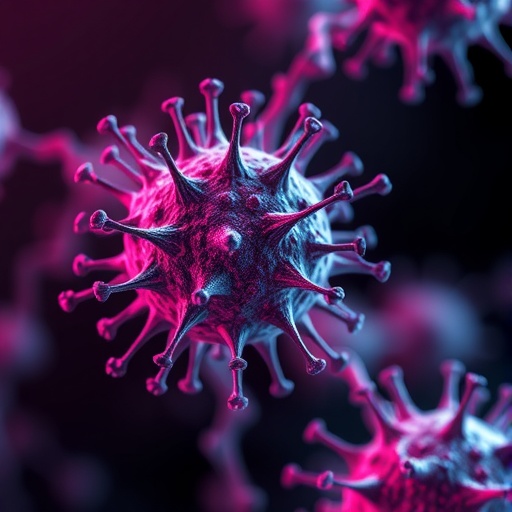In a groundbreaking study that promises to reshape our understanding of innate immunity and viral sensing, researchers have uncovered a novel ATP-dependent mechanism that governs the spatial dynamics of MDA5, a pivotal cytosolic receptor responsible for detecting viral RNA. This discovery not only sheds light on how immune homeostasis is maintained but also opens new avenues for therapeutic intervention against autoimmune disorders and viral infections. The research, recently published in Cell Research, explores the intricacies of molecular movement along cellular filaments and reveals how this motion prevents aberrant immune activation.
At the heart of this discovery lies MDA5 (melanoma differentiation-associated protein 5), a sensor within the cell cytoplasm that recognizes long double-stranded RNA, a molecular pattern commonly associated with viral replication. Under normal conditions, MDA5 forms filamentous structures along RNA ligands, triggering downstream signaling cascades that culminate in the production of interferons and other cytokines. These immune mediators serve as the first line of defense against invading pathogens. However, unchecked or spontaneous assembly of MDA5 filaments, even in the absence of viral RNA, can spur unwarranted inflammatory responses, potentially leading to autoimmune disease.
The study reveals that an ATP-dependent one-dimensional (1D) movement acts as a critical surveillance mechanism that curbs spontaneous MDA5 filament formation. Through sophisticated real-time imaging and single-molecule tracking techniques, the research team demonstrated that MDA5 does not simply statically bind to RNA; instead, it exhibits dynamic lateral movement along RNA strands, harnessing the energy of ATP hydrolysis. This 1D diffusion serves as a quality-control checkpoint, preventing excessive and erroneous filament assembly that could otherwise lead to chronic inflammation.
The biochemical basis for this phenomenon stems from the ability of ATP molecules to regulate the conformation and affinity of MDA5 for RNA substrates. The researchers showed that this ATPase activity is indispensable for the lateral mobility of MDA5, enabling it to scan RNA molecules with high efficiency. This ATP-fueled movement ensures that MDA5 filament assembly occurs only when authentic viral RNA is present, thereby maintaining a delicate balance between immune readiness and tolerance.
Delving deeper into the molecular architecture, the team utilized cryo-electron microscopy and mutagenesis studies to map the interaction interfaces that facilitate MDA5’s mobility along RNA. They pinpointed specific domains within MDA5 responsible for ATP binding and hydrolysis, along with regions mediating RNA contact. Mutations in these domains disrupted the ATP-dependent movement, resulting in constitutive filament assembly and heightened immune activation even in the absence of viral cues. This finding not only underscores the mechanistic importance of motility but also offers a molecular explanation for certain autoimmune pathologies linked to MDA5 dysfunction.
Intriguingly, the spontaneous filament suppression by MDA5’s ATP-driven scanning bears resemblance to mechanisms observed in other nucleic acid sensors and motor proteins, suggesting a conserved evolutionary strategy for immune regulation. By effectively “patrolling” the cellular RNA environment, MDA5 acts as a dynamic sentinel, capable of distinguishing self from non-self nucleic acids and averting pathological self-recognition.
The implications of this research extend beyond basic immunology, with potential applications in clinical contexts. Since MDA5 is implicated in autoimmune disorders such as Aicardi-Goutières syndrome and systemic lupus erythematosus, understanding the kinetically regulated assembly of its filaments could inform the design of novel immunomodulatory drugs. Pharmaceutical modulation of MDA5’s ATPase activity or its filament dynamics might offer a way to dial down inappropriate immune responses without compromising antiviral defenses.
Moreover, this discovery could influence antiviral strategies by enhancing the sensitivity and specificity of innate immune detection. Engineered versions of MDA5 with optimized ATP-dependent movement might be utilized to boost immune surveillance in infected tissues, providing a new layer of defense particularly against viruses that evade detection by conventional sensors.
The study’s integration of biophysical assays, cellular imaging, and genetic perturbations exemplifies a multidisciplinary approach, highlighting the power of combining structural biology with live-cell dynamics. Future research aims to explore how other cofactors and regulatory proteins influence MDA5 mobility and whether similar ATP-dependent mechanisms exist in related cytosolic sensors, such as RIG-I.
Furthermore, the findings prompt a reassessment of how energy metabolism intersects with immune regulation at the molecular level. The reliance on ATP not only links immune sensing to cellular metabolic status but may also reveal vulnerabilities in immune function under conditions of metabolic stress or disease.
This work also raises compelling questions about the temporal dynamics of immune activation — how quickly can MDA5 switch from a scanning mode to an activated filamentous state upon encountering viral RNA? Does the ATP-driven movement affect the kinetics of downstream signaling complex assembly? Addressing these queries could provide a more holistic view of immune system responsiveness in health and disease.
The viral implications of controlling spontaneous filament formation are profound. Viruses often employ strategies to subvert innate immune detection; thus, understanding and potentially manipulating the ATP-dependent scanning mechanism of MDA5 might unearth new antiviral therapeutic strategies. This novel insight enhances our molecular toolkit for combating emergent and re-emergent viral threats.
In summary, this pioneering investigation fundamentally advances our comprehension of immune homeostasis maintenance mechanisms. By elucidating how ATP-dependent 1D movement suppresses spontaneous MDA5 filament assembly, the study bridges gaps between molecular biophysics, cellular immunology, and clinical pathology. It underscores the sophistication with which the immune system employs energy-dependent processes to maintain tolerance while staying vigilant against pathogens—an elegant molecular dance that balances defense and restraint.
As the scientific community digests these findings, the prospect of targeting MDA5’s ATPase-driven mobility holds promise not only for fine-tuning immune responses but also for inspiring innovative therapeutic modalities. The journey from molecular discovery to clinical application is likely to be rapid and transformative, signaling a new era in precision immunology and antiviral defense.
Subject of Research: Innate immune regulation via MDA5 filament assembly and ATP-dependent molecular movement
Article Title: ATP-dependent one-dimensional movement maintains immune homeostasis by suppressing spontaneous MDA5 filament assembly.
Article References:
Han, XP., Rao, M., Chang, Y. et al. ATP-dependent one-dimensional movement maintains immune homeostasis by suppressing spontaneous MDA5 filament assembly. Cell Res (2025). https://doi.org/10.1038/s41422-025-01183-8
Image Credits: AI Generated
Tags: aberrant immune activation preventionATP-driven immune regulationautoimmune disorder therapiescellular filament dynamicsimmune homeostasis maintenanceinnate immunity mechanismsinterferon production pathwaysMDA5 receptor functionmolecular movement in immune cellsspatial dynamics of MDA5therapeutic interventions for viral infectionsviral RNA detection





